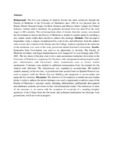Please use this identifier to cite or link to this item:
https://cris.library.msu.ac.zw//handle/11408/2898| Title: | Lessons learned during establishment of the college of health sciences of the University of Zimbabwe 1995-2001 | Authors: | Mufunda, Jacob Samkange, Christopher Sigola, Lynette Matchaba-Hove, Reginald |
Keywords: | Medical education Upgrading from Faculty of Medicine to College of Health Sciences Ownership of teaching hospital Strategic plan |
Issue Date: | 2017 | Publisher: | European journal pharmaceutical and medical research | Series/Report no.: | European journal pharmaceutical and medical research;Vol. 4, No. 3; p. 155-159 | Abstract: | Background: The five year training of medical doctors has been conducted through the Faculty of Medicine of the University of Zimbabwe since 1963 in two physical sites in Harare; Mount Pleasant Campus for Basic Sciences and Mazowe Street Campus for Clinical Sciences. Annual student enrolment has gradually increased from less than 30 in the early stages to 200 currently. The continuing brain drain of doctors from the country necessitated the Government to instruct the Faculty of Medicine to double its student intake by enrolling a new student intake within three months to address this shortage. Methods: This descriptive longitudinal study is largely complemented by desk review and reflections from the authors who oversaw the evolution of the Faculty into the College. Authors experienced the transition of the institution over most of the study period and shared first-hand information. Results: Instruction from Government was used as an opportunity to develop. The Faculty of Medicine developed and began implementation of its inaugural five year strategic plan 1995-2001. The key tenets of the plan were to be a semi-autonomous institution (in relation to the University of Zimbabwe) comprising five Faculties with a designated teaching hospital under joint administration with Government where academicians were to receive similar emoluments. Clinicians were entitled to additional remuneration from Government for the clinical work delivered. The infrastructure was expanded to accommodate 200 medical students annually at the two sites. A government loan secured from the Spanish Protocol was used to purpose build the Health Sciences Building and equipment to accommodate and equip the five faculties. Discussion: The directive by Government to double medical student intake in order to address the doctor shortages was used as opportunity to address some of the Faculty of Medicine’s academic needs, including infrastructure, professional development and additional academic provisions in line with international trends. The realization of some of the outcomes is on course with the exception of ownership of a teaching hospital, autonomy of the College from the University and additional emoluments for clinicians from government, which are work in progress. | URI: | http://www.ejpmr.com/admin/assets/article_issue/1488345698.pdf http://hdl.handle.net/11408/2898 |
ISSN: | 2394-3211 |
| Appears in Collections: | Research Papers |
Files in This Item:
| File | Description | Size | Format | |
|---|---|---|---|---|
| Abstract.pdf | Abstract | 108.68 kB | Adobe PDF |  View/Open |
Page view(s)
114
checked on Jan 18, 2026
Download(s)
20
checked on Jan 18, 2026
Google ScholarTM
Check
Items in MSUIR are protected by copyright, with all rights reserved, unless otherwise indicated.



